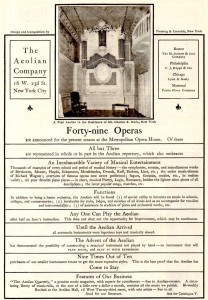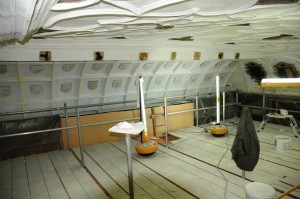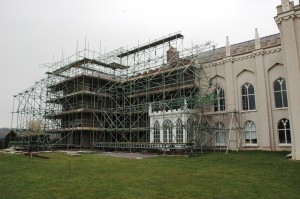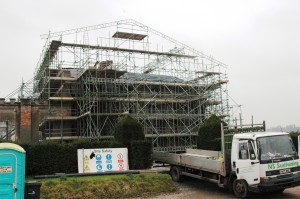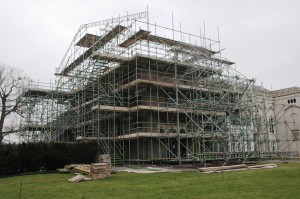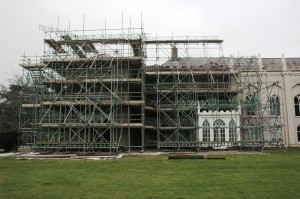 The Library ceiling, seen from the north west, after conservation and just before the scaffolding platform was removed. The wall to the left is the east wall, and wall to the centre and centre-right is the south wall. The wall on the extreme right – the only wall with windows (which look over the lake), is the west wall.
The Library ceiling, seen from the north west, after conservation and just before the scaffolding platform was removed. The wall to the left is the east wall, and wall to the centre and centre-right is the south wall. The wall on the extreme right – the only wall with windows (which look over the lake), is the west wall.
We have discussed before the large heraldic shields on the east, south and west coving of the Library ceiling, but now that the shields have been cleaned there is an excellent opportunity to really examine them. These are the shields which were painted on flat board, which was then in turn attached to moulded, scrolled surrounds. The finished shields were each bolted through the plaster to the beams behind. In each case just two bolts were used, which resulted in several shields have cracked along a straight line between the centrally-located bolts (and for the conservators it was a very fiddly job to get to the nuts in the roof space above the ceiling).
Most of the shields are dated, in an oval cartouche mounted above the shield (separate from the shield itself). The majority of the shields commemorate marriages, and two sets of surnames are painted on to the outer surround. The name Cotton appears on all but one, and on the remaining one Corbet appears instead. There are eighteen ‘named’ shields.
The earliest date on a shield is 1245 – on the far left of the south wall, and then four are undated. A further five – on the east wall – are neither dated nor inscribed with any surnames. The dating resumes at 1461, and that included, there are fourteen more dated shields – the last being 1838.
The dates vary in significance; some are the dates of marriages – when the surnames were joined – as might be expected, while at least one other is the date of a death.
SOUTH WALL
 Extreme left, undated, un-named:
Extreme left, undated, un-named:
 Second from left, undated and un-named
Second from left, undated and un-named
 The third arch from left is unoccupied. To the right of that, in the centre, is the carved wood panel dated 1580, with a large plaque below showing thirteen coats of arms. It is hard to see what the date of 180 signifies; there doesn’t see to be anything in the births, marriages and death of the Cotton family which occurred on that year. It may refer to the completion of the work on the Abbey, which will have been about that time, under the ownership of Richard Cotton (1539 – 1602).
The third arch from left is unoccupied. To the right of that, in the centre, is the carved wood panel dated 1580, with a large plaque below showing thirteen coats of arms. It is hard to see what the date of 180 signifies; there doesn’t see to be anything in the births, marriages and death of the Cotton family which occurred on that year. It may refer to the completion of the work on the Abbey, which will have been about that time, under the ownership of Richard Cotton (1539 – 1602).

 Third from the right, undated, named Corbet and Cotton.
Third from the right, undated, named Corbet and Cotton.
In 1772 Hester Salusbury Cotton (born 6.2.1753), daughter of Sir Lynch Cotton, married Sir Corbet Corbet Bt. Of Stoke-on-Trent, Staffordshire at Wrenbury church. He was the son of Colonel Thomas Davenant of Pembridge, Herefordshire, and Anne Corbet (second wife) of Stoke-on-Tern, Shropshire. Sir Corbet seems to have taken mother’s surname. Anne was daughter of Sir Robert Corbet (c. 1670 – 1740), and her son seems to have inherited the baronetcy. This marriage created a connection between the Cotton family and the ancient and very well-connected Shropshire family or Corbet. Hester’s mother was Elizabeth Abigail Cotton 1714 – 4.1.1777 of Bellaport, Shropshire, daughter of Rowland Cotton (born c. 1669).
The raven is the crest of the Corbet (or Corbeau) family who were established in Shropshire after the Norman conquest by Hugh Corbet. The red hand is normally the crest of Ulster, but it’s presence here is difficult to explain. The three silver or white Cotton twists on a blue field, with a white or silver chevron is the heraldry of the Cotton family of Shropshire. The family were never involved in the cotton trade; it is a visual pun on their name.
 Second from right, undated and un-named:
Second from right, undated and un-named:
 Extreme right, undated and un-named:
Extreme right, undated and un-named:
WEST WALL
Hugh de Cotton, 1245
 The first person we know of in the Cotton line was Hugh of Hodnet, whose son Alan de Cotton lived between 1290 and 1320. As his wife (see below) was born circa 1270, 1245 cannot be the date of a marriage, but could be the supposed date of his birth. a sate for his birth does not seem to be recorded anywhere. Whether or not this coat of arms is genuine is open to debate.
The first person we know of in the Cotton line was Hugh of Hodnet, whose son Alan de Cotton lived between 1290 and 1320. As his wife (see below) was born circa 1270, 1245 cannot be the date of a marriage, but could be the supposed date of his birth. a sate for his birth does not seem to be recorded anywhere. Whether or not this coat of arms is genuine is open to debate.
Cotton – Titley, 1245
 A reference to the marriage of Hugh of Hodnet to Elizabeth, daughter of Hamon de Tittenleigh (born circa 1230). The archivist Henry Spelman (1562 – 1642) had mention of Tittenleigh as a surname appearing in Nantwich.
A reference to the marriage of Hugh of Hodnet to Elizabeth, daughter of Hamon de Tittenleigh (born circa 1230). The archivist Henry Spelman (1562 – 1642) had mention of Tittenleigh as a surname appearing in Nantwich.
Cotton – Hackett undated

No information at present
Cotton – Haydon undated

A reference to Heyton. Hugh de Cotton, grandson of the first Hugh we know of in the Cotton family, and son of Alan de Cotton, was born circa 1313, probably in Hodnet in Shropshire. He married Isabel de Heyton (born 1313 or 1315). Heyton – now Eyton – is south east of Shrewsbury. Isabel was the daughter of Thomas de Heyton, born in 1290, whose residence is given as both Hodnet and Ludlow. Hugh and Isabel’s only known child is their heir, Hugh Cotton – born circa 1335 – was known as Hugh of Rudheath. Rudheath is a village south east of Northwich in Cheshire.
Cotton – Acton undated

Alan de Cotton of Hodnet lived between 1290 and 1320, and married Margaret of Acton (born c. 1295), daughter of Roger Hellesby of Acton (born 1273). The date of their marriage is given as 1319, but that cannot be the case as their son and heir, Hugh, was born circa 1313 (see above), and Margaret would have been 46.
Cotton – Young, 1461

William Cotton was born in Wem in north Shropshire in around 1432. He was the son of (another) William Cotton, who married Elen de Grymelond of Alkington. William junior married Agnes Yonge of Caynton (Cainton) in Shropshire. We have no record of Agnes’s date of birth but she died around 1516. She was the daughter of Sir Philip Yonge (died 1459) and Agness de Peshale (daughter of Robert de Peshale). Agnes’s brother was the Sheriff of Shropshire, Sir William Yonge. William and Agnes’s son, John Cotton, was born in circa 1464 and became a successful lawyer in London, and later, at the court of Henry VIII. William’s marriage to Agnes seems to have moved the Cotton family up the social ladder. 1461 is presumably the date of the marriage and therefore the association between Cotton and Yonge.
Cotton – Mainwaring, 1500

John Cotton, who was born circa 1464, was the son of William Cotton (junior). He married Cecily Mainwaring of Ightfield in north Shropshire (‘Istefelt’ in Domesday Book). John was born in Wem. From this date of 1500 one surmises that he married Cecily then.
Cotton – Ongley, 1545

John Cotton’s elder son, Sir George Cotton, married Mary Onsley (or Ongley or Onley). She came from Catesby Castle in Northamptonshire, and died in 1559 or 1560. They had five children ; the first born in 1528 and the penultimate in 1539. Their only son was the fourth-born, Richard (1539 – 1602) – who was not the courtier to Henry Fitzroy; that was his uncle. Sir George Cotton and his brother Sir Richard (two years the younger) were very successful Tudor courtiers. Sir Richard, who established the household of Henry VIII’s illegitimate son, The Duke of Richmond, made his home at Bedhampton in Hampshire. – on manors which had been gifted to him. George was gifted Combermere Abbey after the Dissolution. The date of 1545 was the date of George’s death (March 25 1545). His son, Richard, inherited.
Cotton – Mainwaring, 1570

A Cotton married into the Mainwaring family of Ightfield again in – presumably – 1570. Richard Cotton, son of Sir George Cotton, (1539 – 1602), married Mary Mainwaring of Ightfield. Richard, aided one imagines by Mary, did much to improve the Abbey and turn it from a great ecclesiastical pile into a then-modern country house. They had six children, the second-born – George (circa 1565 – 1647) being the heir. Mary died in 1578 at the age of 37. Richard had three other wives; Agnes Shatbolt (one daughter; possibly called Mary), Jane Gulliard or Silliard (possibly one daughter; Jane), and Philippa. It is possible that the marriage to Agnes Shatbolt pre-dated the marriage to Mary Mainwaring, but not certain.
Cotton – Shelley, 1596

This is curious; the date of 1596 does not match any known Cotton marriages or deaths.. The son (the eldest of three) and heir of Richard and Mary, George Cotton ( circa 1565 – circa 1647) married Mary Bromley of Shifnal (circa 1569 – 1647). Mary Bromley was the first of the highly-fecund Cotton wives, giving birth to eleven children between about 1588 and 1609. The best date for marriage is 1585, when the bride was just 16 (and Mary lived to a great age despite the large number of pregnancies). The first ten children were girls, and a son only appeared at the end of the run in 1609 (Thomas, who died in around 1646). All their children were too young to be married in 1596. Looking at George’s siblings, it is possible that one of them was married to a Shelley in 1596. His brother Arthur (born circa 1562) may have married an unknown woman with the surname Shelley. Another brother, whose possible birth date ranges from 1564 to 1575, could also be a candidate for a marriage to a Shelley. The youngest daughter, Frances (born circa 1573) married Sir George Abell, but any of the other daughters could conceivably made a match with a Shelley, thought august enough to be added to the family heraldry.
Cotton – Bromley, 1600

George Cotton (1560 – circa 1649) married Mary Bromley of Shifnal (1569 – 1647). The date we have for that is 1585. It is thought that their first seven children (of eleven) were born before 1600, but this may be wrong, and 1600 may be the date of their marriage – though it does seem late. The only definite date for the birth of one of their children is 1609 for the last, their only son and heir, Thomas (died circa 1646). He and his son George both died during the Civil War, though whether or not it was as a result of the war we do not know. This Thomas Cotton is not the man of that name who was curator of his father’s library in London at much the same time.
Corbet – Needham undated

Thomas Cotton married Frances Needham, daughter of the first Viscount Kilmorey, on November 10 1624. Her date of birth is not known but she died around 1629. She gave birth to a daughter in that year, who was also named Frances – and from that it is possible to assume that the mother died in or soon after child-birth. Frances was therefore the only Cotton wife who we can assume, more or less as a probability, died as a direct result of child-birth. She had previously borne George, circa 1625, and Mary, circa 1627. Viscount Kilmorey was born Robert Needham in circa 1656, at Shavington, near Adderley in Shropshire (not Shavington near Crewe). He served in Ireland and was knighted in 1594 (when he inherited Shavington Hall from his late father, Sir Robert Needham), and was created Viscount Kilmorey in 1625. He died in 1631. The date to accompany this shield should therefore be 1624, the date of the marriage which united the two families.
Cotton – Blount, 1625

The connection between the Cotton and Blount families steps to one side of the direct line of male descent in the Cotton family. The younger brother of Sir George Cotton (died 1545), Sir Richard Cotton (circa 1497 – 1556) married Jane Onsley (presumably the Jane Onsley of Sir George’s wife, Mary Onsley – both daughters of John Onsley, who was married to Jane Pontesbury of Albrighton in Shropshire). Richard and Jane had three children; two daughters, both of whom made good marriages – Elizabeth, the elder, married Sir Henry Longeuville, and Susanna, the youngest child, married Charles Grey, Baron Grey of Ruthin and Earl of Kent. Their son and heir, George Cotton married Mary Shelley, and they had three children – Mary, Jane, and Richard. Richard married Elizabeth Blount. 1625 is acceptable as the date of their wedding.
Cotton – Calverley, 1630

Thomas Cotton, eleventh and last child of George Cotton (circa 1560 – 1647) and Mary Bromley of Shifnal (circa 1569 – circa 1647), was born on August 1 1609 and lived until around 1646. He married, firstly, Frances Needham in 1624) and secondly, Elizabeth Calveley of Lea in Cheshire on march 10 1635. The date of their marriage is well recorded, so the date of 1630 on the shield seems erroneous. This seems to have been a profitable marriage. Elizabeth was third daughter of Sir George Calveley of Lea. She was the eldest sister and eventually co-heiress of Sir Hugh Calveley. She and Thomas had three children; Sir Robert Cotton (1635 – 1712), Lieutenant-Colonel Charles Cotton (born circa 1637), and Lettice (circa 1642 – circa 1710). Sir Robert out-lived his half-brother George (who died around the time of his father’s death, in 1646), and inherited Combermere Abbey. His marriage to Hester Salusbury brought the great estate of Llewenny into the family.
Cotton – Salusbury, 1677

As noted above, Sir Robert Cotton (1635 – 1712) married Hester Salusbury of Llewenny (died 1710). The accepted date for their marriage is 1658, and 1677 seems much too late – especially as George and Hester had sixteen children. Their heir was the eleventh birth, Sir Thomas Cotton (circa 1672 – 1715).
Cotton – Lynch, 1704

Sir Thomas Cotton, son of Sir Robert and Hester, was probably born in 1672, at Llewenny. He married Philadelphia Lynch (1675 – 1758). Philadelphia was the daughter and heiress of Thomas Lynch of Esher in Surrey, governor of Jamaica, and his wife Vere, the sister of the Earl of Torrington. That marriage will have further enriched the Cotton family. 1704 cannot be the date of their marriage as Sir Thomas died in 1715 and he and Philadelphia had sixteen children (as had the previous Cotton generation). A date of 1689 for their marriage seems correct, with the birth-dates of their children stretching between 1691 and 1714). The two year gap between marriage and the first birth is probably accounted for by Philadelphia, fourteen years old at the time of her wedding, coming to maturity.
Cotton – Tollemache, 1730

Sir Robert Salusbury Cotton (1695 – 1748), fourth child and third son of Sir Thomas and Philadelphia, married Elizabeth Tollemache (1682 – 1745) of Hellingham in Suffolk. The date we have for the marriage is 1720. She was the eldest daughter of Lionel Tollemache, Earl of Dysart and Huntingtower (a title he inherited through the distaff line; his father was a baronet) who was born in 1649 and died in 1727. The marriage of Sir Robert and Elizabeth produced no progeny. On his death the line continued through his brother, Sir Lynch (circa 1702 – 1775).
Cotton – Cotton 1740

Sir Lynch Salusbury Cotton married Elizabeth Abigail Cotton of Bellaport in Shropshire at some date before 1738 (probably 1734, certainly not 1740), and they had fourteen children, with the last born circa 1755. Elizabeth, who was born in 1714 and died in 1777, was the daughter of Rowland Cotton of Bellaport (born circa 1669) and Mary Sleigh (born circa 1673) of Etwall in Derbyshire, daughter of Sir Samuel Sleigh. There were two men with the name Sir Rowland Cotton, who were Members of Parliament; one lived 1581 – 1634, and the other 1674 – 1753. Elizabeth’s father was the latter, son of Ralph Cotton and Abigail Abney. He lost his seat in Parliament in 1715 for supported the Jacobites. The other Sir Rowland Cotton was his grandfather. There seems to have been a distant relationship between the two Cotton families, with Sir Rowland’s branch, which turned to Catholicism, descended from Sir Richard Cotton (circa 1497 – 1556).
Cotton – Pelham Clinton, 1800

The sixth child of Sir Robert Salusbury Cotton (1739 – 1809) and his wife Frances Stapleton (died 1809) – who married in 1767 – was Field-Marshal Sir Stapleton Stapleton-Cotton of Bhurtpore, who was born at Llewenni in 1773 and died in 1865. His first of three marriages was to Anne Marie Pelham-Clinton of Clifton in Bristol (1783 – 1807). They had one child; Robert Henry Stapleton-Cotton (1802 – 1821) who did not inherit due to his early death. She was the daughter of Thomas Pelham-Clinton, Duke of Newcastle. Anne Marie and Stapleton married on January 1 1801 at Clumber Park in Nottinghamshire, the Newcastle’s family seat. Given that the wedding date of 1800 is well documented it is curious that this shield bears a date of 1800.
Cotton – Greville, 1814

Sir Stapleton’s second marriage was to Caroline Greville (died 1837) on June 18 1814 – so the date on the heraldry is correct for the wedding. They had three children; Caroline Frances Cotton (1815 – 1893) who married the Marquis of Downshire in 1837; their heir, Wellington Henry Stapleton-Cotton, second Viscount Combermere of Bhurtpore (1818 – 1891), who married Susan Alice Sitwell (1819 – 1869) in 1844; and Meliora Emily Ann (1825 – 1897), who married John Charles Frederick Hunter in 1853. After 1830 Caroline lived apart from her husband. Her parents were William Fulke Greville and Meliora Southwell.
Cotton – Gibbings, 1838

On October 2 1838 the then very grand Field-Marshal Sir Stapleton Stapleton-Cotton, first Viscount Combermere of Bhurtpore took Mary Woolley Gibbings (1800 – 1889) of Kilbolane in County Cork as his third wife. There were no children, and the heir remained Wellington Henry Stapleton-Cotton, child of the Viscount’s second wife. Mary’s father was Robert Gibbings, a doctor and apothecary of Irish descent but then working in Cheltenham. The Viscount often took that waters at spa towns and this may well have been how he met Mary.
We do not know exactly when the Cotton arms were added to the early-Seventeenth century coving on The Library ceiling, but if it were in the years after the first Viscount’s third marriage, that would not be surprising. They seem to have been planned all at the same time. the second Viscount was a month past his twentieth birthday when his father married for the third and final time, and he was perhaps involved in the researches into their ancestors and their heraldry. It is possible that the son started – or continued – the work – but his marriage, in 1844, was not included, so the work was doubtless finished by then. Two arched panels on the south wall are blank and there is no obvious reason for this.
 The electrical master control box on the wall by the pump. This would be switched off when the organ was not in use, and would have protected the other electrical items in the house.
The electrical master control box on the wall by the pump. This would be switched off when the organ was not in use, and would have protected the other electrical items in the house.

 The Combermere organ, with the large aperture to take the ‘automatic play’ cylinder open
The Combermere organ, with the large aperture to take the ‘automatic play’ cylinder open
 A close-up of a cylinder in position
A close-up of a cylinder in position
 And the same aperture without a cylinder
And the same aperture without a cylinder



